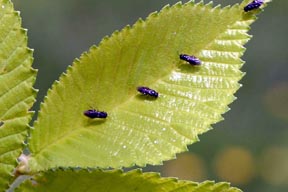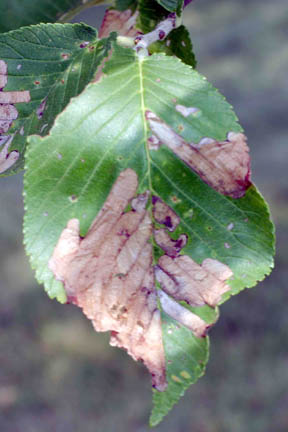Elm Leafminers | |
|---|---|
| May 28, 2008 | |
|
Two leafminers that attack elm in northern Illinois are active and controllable at this time. Neither appears to be a threat to tree health, but their tunneling through the mesophyll of the leaf causes considerable aesthetic injury, particularly the elm leafminer.  Elm leafminer adults. Elm leafminer, Fenusa ulmi, is a sawfly native to Eurasia, where it is called the elm-leaf-mining sawfly. It attacks primarily Eurasian elms, including Scotch, Camperdown, and English elm; but it also attacks American elm. The adult, which looks like a black wasp with smoky black wings and is about 1/8 inch long, emerges from overwintering pupae in the spring. The adults are primarily parthenogenetic, meaning that they are females capable of producing viable eggs without males. Sawflies are named for the ovipositor, egg-laying structure of the female, being sawlike and capable of making slits into plant tissue to lay eggs. These adult sawflies are currently making slits into elm leaves and laying their eggs. Eggs hatch about a week later into whitish larvae with brown heads that tunnel between the upper and lower epidermises of the leaf in the spongy and palisade cells that make up the leaf mesophyll. They have brown-banded legs. The mines initially appear as white spots, but they soon enlarge into blotch mines. The blotch mines of this leafminer appear as wide, elongated areas tunneled out between the lateral leaf veins. Newly damaged areas are whitish transparent, but soon adjacent epidermal cells die and turn brown. Later in the spring, the larvae mature and drop to the ground to pupate. They tunnel down into the soil about 1 inch and pupate within a papery cocoon. They remain in the pupal stage throughout the summer, fall, and winter, emerging in the spring as adults.  Elm leafminer damage. Damaged leaves remain on the tree throughout the growing season. Frequently, the brown damaged areas drop out of the leaves, leaving irregular elongate holes. Both the brown mines and the holes represent obvious aesthetic damage. Elm flea weevil is probably Rhynchaenus alni, another insect that is originally from Eurasia, where it is called the elm-leaf-mining weevil. This is a tiny insect, about only 1/16 inch long. It is reddish, with black spots on the wing covers, and has on elongated snout with tiny mouthparts at the end. Adults overwinter, emerging in the spring to feed on leaves of Eurasian elms, including Siberian elm, where the damage is most noticeable. It also feeds on American elm.  Elm flea weevil adult and damage. Adult feeding occurs initially as pinhead-sized, round holes in the foliage. These holes enlarge through additional feeding and/or dieback into larger, more noticeable holes. Many holes are produced, making them the easiest way to detect this weevil’s presence. Close examination reveals the tiny weevils on the leaf. When disturbed, they jump and fly, earning them the flea in their name. At this time of the year, many of the weevils will be copulating pairs, making them easier to approach. Flea weevils chew holes partway through the leaf tissue and then turn around and lay an egg in the hole. These hatch into legless, white larvae that mine through the mesophyll leaf tissue at the leaf tips, creating leaf tips that are initially whitish but soon turn brown. From a distance, this damage is much less obvious than that of the elm leafminer; but because both are typically present, it becomes an additive effect on tree appearance. When fully grown, the larvae pupate within the mine and emerge as adults in August. After feeding, they seek overwintering sites in protected locations. They emerge in the spring to feed on the new foliage. Control of both insects is primarily directed against the adults. Sprays of acephate (Orthene), imidacloprid (Merit), bifenthrin (Onyx. Talstar), or carbaryl (Sevin) should provide control. The Orthene and Merit should also prevent the larval mines from appearing later. | |
| Author: | Phil Nixon Morton Arboretum |
